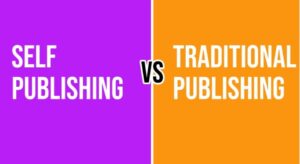Self-Publishing vs. Traditional Publishing,Which Is Right For You?

Congrats on writing a book! That’s a big deal. But now what? How do you get it published? You have two main options: self-publishing or traditional publishing. Each choice has good and bad sides. The best path depends on your goals, budget, and what works for you. In this guest post for Mayfair Publishers, we’ll explain the differences between self-publishing and traditional publishing to help you choose the right option for your book.
What is Traditional Publishing?
Most people think of traditional publishing when they picture a book being published. With traditional publishing, you work with a publishing house. They do most of the work to get your book to the readers.
Here’s how it generally works:
1. Find an Agent (Sometimes):
Many authors get a literary agent to help sell their book to publishers.
2. Submit the Manuscript:
The agent (or sometimes the author) sends the book to editors at publishing houses.
3. Get Approved:
If an editor likes the book, they show it to a committee. The committee decides if they want to publish it.
4. Sign a Contract:
The agent helps the author agree on the contract details, like payment and book rights.
5. Edit the Book:
The book goes through several edits to make it as good as possible.
6. Design the Book:
The publisher’s team creates the book cover and designs the pages.
7. Print and Distribute:
The publisher prints the book and sends it to stores and online sellers.
8. Promote the Book:
The marketing team works to get people excited about the book.
This whole process can take time, but the publisher handles a lot of the work!
Advantages of Traditional Publishing:
1. Respect and Trust:
Getting published by a traditional publisher can make your book look more professional and respected.
2. Expert Help:
You get support from editors, designers, marketers, and other publishing pros.
3. More Places to Sell:
Traditional publishers have connections to bookstores, so your book can reach more readers.
4. Money Upfront:
Some publishers give you an advance payment, which helps you earn money while you write.
5. Less Work for You:
The publisher takes care of most of the hard work, so you can focus on writing your book.
Traditional publishing can make things easier and help your book go far!
Disadvantages of Traditional Publishing:
1. Takes a Long Time:
Traditional publishing can be slow. It might take 1-2 years (or more) to see your book in stores.
2. Less Creative Control:
You don’t get to make all the decisions. The publisher usually chooses the cover, title, and marketing plan.
3. Smaller Earnings:
You might earn less money per book sold compared to self-publishing.
4. Hard to Get Accepted:
Many authors face rejection before landing a traditional publishing deal.
Traditional publishing has some downsides, but it can still be worth it for the right author!
What is Self-Publishing?
Through self-publishing also known as indie publishing authors gain full independence to oversee every aspect of the publishing process.
Here’s an overview:
1. Edit and Format:
The author does all the editing, proofreading, and formatting for the book.
2. Design the Book:
The author can hire a designer or use design software to make the book cover and layout.
3. Print and Share:
The author uses print-on-demand services or works with a printer to make physical copies. They also handle ebooks and audiobooks.
4. Promote the Book:
Authors conduct all promotional activities to achieve better book distribution to readers.
Self-publishing provides developers with considerable control however they must independently perform most tasks involved.
Advantages of Self-Publishing:
1. More Control:
You get to make all the decisions about your book, from the cover design to the marketing.
2. Publish Faster:
You can get your book out to readers much quicker than with traditional publishing.
3. Earn More Money:
You usually make more money per book sold with self-publishing.
4. Connect with Readers:
You will encounter multiple opportunities to engage readers personally in addition to growing your fan community.
Self-publication offers both complete control and generates higher income percentages compared to traditional publishers do.
Disadvantages of Self-Publishing:
1. More Work for You:
You have to do everything yourself, from editing to marketing. This can take a lot of time and energy.
2. Pay Upfront:
You need to spend money on things like editing, design, and other services before you make any sales.
3. Harder to Get into Stores:
It can be tough to get your self-published book on bookstore shelves.
4. Marketing is All on You:
You have to handle all the advertising and promotion to get people interested in your book.
Self-publishing gives you control, but it also means more responsibility!
Which Path is Right for You?
Deciding between self-publishing and traditional publishing is a personal choice. Think about these things:
1. Your Goals:
What do you want from your book? Are you hoping to make money, reach lots of readers, or just share your story?
2. Your Resources:
Do you have the time, money, and skills to handle self-publishing?
3. Your Personality:
Are you okay with marketing and promoting your book? Do you like working alone or with a team?
Here’s a Quick Guide:
-
Choose Traditional Publishing If:
You want respect and support from professionals and don’t mind waiting for your book to come out.
-
Choose Self-Publishing If:
You want full control, need a faster process, and feel good about managing the business side of things.
The most effective method to decide involves gaining knowledge about your two available choices. Other authors should be consulted regarding the advantages and disadvantages before selecting what aligns with personal needs and ambitions.
Good luck on your publishing journey!
Want more insights? Keep visiting Lotology for the latest updates and information!
